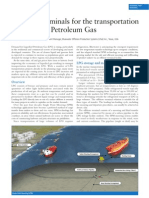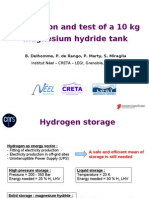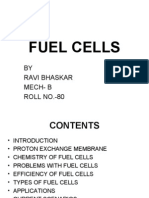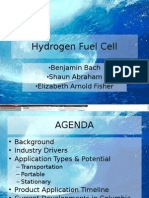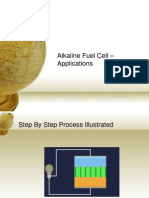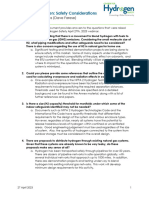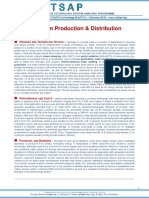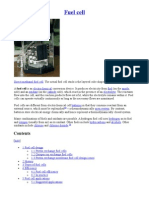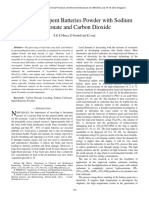Hydrogen Storage
Hydrogen Storage
Uploaded by
Boulos NassarCopyright:
Available Formats
Hydrogen Storage
Hydrogen Storage
Uploaded by
Boulos NassarOriginal Title
Copyright
Available Formats
Share this document
Did you find this document useful?
Is this content inappropriate?
Copyright:
Available Formats
Hydrogen Storage
Hydrogen Storage
Uploaded by
Boulos NassarCopyright:
Available Formats
Walt Pyle
1997 Walt Pyle
Above: LPG tanks used as medium pressure storage for hydrogen and oxygen.
ydrogen storage is needed for homes, businesses, and vehicles, to realize the dream of the Solar Hydrogen Age. Since hydrogen gas is useful as a fuel for cooking, heating, electricity production, and vehicle propulsion, we need a way to store the solar hydrogen made during the day for use at night, and seasonally as well.
For more insight on how this wonderful fuel can be used and produced see HP# 33 and 43 for articles on cooking with hydrogen, HP# 34 for space heating with hydrogen, HP# 35 for making electricity with hydrogen, and HP# 22, 36, 39 for articles on hydrogen production from PV and wind electricity. Most home energy use occurs in the evening when there is no solar hydrogen production occurring from a home hydrogen plant. Over-night hydrogen storage can solve this problem. Summer-time solar hydrogen production can meet or exceed home consumption requirements. Winter-time hydrogen demand (for heating) is maximum at the time when solar hydrogen production is at a minimum. Seasonal home storage can correct this out-of-phase relationship.
Vehicles require on-board storage of hydrogen fuel, and fuel providers away from home (service stations) require larger bulk hydrogen storage capacity. Storage options for hydrogen to be used at home are considered in this article. What are some of the storage options for hydrogen? Many different schemes have been investigated and applied in research programs and demonstrations since the first oil shock in 1973. Some of the options are listed below: compressed hydrogen gas (CHG) in cylinders or tanks tethered balloon, bag, or water displacement tank (low pressure CHG) hydrogen adsorbed into metal to form metal hydride (MH) liquid hydrogen (LH2) in cryogenic tank adsorption on high-surface-area carbon powder in tank encapsulation in glass micro-spheres (experimental) adsorption on carbon nano-tubes (experimental) in water (H2O) (not a fuel)
14
Home Power #59 June / July 1997
Hydrogen
in ammonia (NH3) in liquid hydro-carbons: gasoline, diesel fuel, alcohol, liquid natural gas (LNG), propane or butane (LPG), etc. in gaseous hydrocarbons: compressed natural gas (CNG), bio-gas, etc. The first three hydrogen storage options above, CHG, MH, and LH2, are the stateof-the-art methods most frequently applied in vehicular and stationary applications. The energy density of different hydrogen storage options are shown below, and compared to that of gasoline.
M od ul PV
Hydrogen Gas
Solar Hydrogen System
Hydrogen Gas
Oxygen Gas
Hydrogen Purifier
Oxygen Purifier
es
Electric Power Controller
Electrolyzer
The last two hydrogen storage options, using liquid and gaseous hydro-carbons, are the fossil-fuels that dominate our global fuel production and consumption systems today. For example, a large amount of hydrogen is added to petroleum feedstock to make gasoline. These liquid hydrocarbon fuels are widely used in transportation because of their extremely high energy density.
Electric Utility Grid
Electrolyte Tank
Makeup Water Purifier
In this article we are focusing on the CHG and MH storage options, since they are the easiest to implement for home power applications at this time. LH 2 production requires a large energy-expenditure for refrigeration to liquefy gaseous hydrogen. LH 2 is primarily used for transportation applications, so we choose not to elaborate on this method now. We also gloss over the experimental hydrogen storage options in this article, since their values are still being proven. Safety First! If hydrogen is to be stored, it must first be made safe to store. Hydrogen and air, or hydrogen and oxygen
mixtures are not safe to store if the O2 contamination is significant. Hydrogen has much wider flammable and explosive limits compared to other fuels, especially in hydrogen-rich mixtures with air or oxygen. Hydrogen flammable limits are shown on page 16 and compared to some common fossil fuels. Hydrogen should never be stored unless it is well below the lower flammable limit (LFL). Normally, industry standards for storage safety call for well below 0.25 LFL, (or less than 1% oxygen in the hydrogen.) To meet this standard, some way of accurately measuring the oxygen contaminant in the produced solar hydrogen must be available. Some hydrogen sensors are listed in the access section at the end of this article
Gross Energy Densities of Various Fuel Systems
100 Volumetric Energy Density (MJ/L)
Gasoline Hydrogen in Metal Hydrides Hydrazine Ammonia Liquid Methane Liquid Hydrogen Cyclohexane/ Benzene Compressed Gaseous Hydrogen
Methanol
10
1 1 10 100 1000
Gravimetric Energy Density (MJ/kg)
Home Power #59 June / July 1997
15
Hydrogen
100 90 80 70 Volume % 60 50 40 30 20 10 0 4 Hydrogen in Air 18.2 75 58.9
Hydrogen Flammability Limits Compared to Other Fuels
93.9 90
Flammability Limits Detonation Limits
15 5 Methane in Air
14 6.3
9.5 2.1 Propane in Air
7.6 1 Gasoline in Air
15 3.3 1.1 4.7 Hydrogen in Oxygen
Compressed Hydrogen Gas (CNG) CHG is one of the simplest methods for storing hydrogen fuel for later use. The hydrogen storage density becomes greater as the pressure is increased. Hydrogen production from an electrolyzer can provide pressures suitable for storage at low and medium pressures. Low-pressure CHG is the basis for balloon or bag storage, often seen used for weather balloons or for bag storage of fuel gas. The same principle is applied to hydrogen storage that has been used for natural gas storage at low pressure: bus roof storage bags and underground water displacement tanks. Low-pressure tanks are widely used in China and India for storage of bio-gas fuels. Pressures in these low-pressure CHG containers are only slightly above atmospheric pressure, and they are characterized by very large volume and low container weight. Medium Pressure CHG Storage This type of storage has been done using tanks originally designed for air or propane (LPG) service. Typically these tanks are rated for about 17 bar (250 psig) maximum pressure in the intended service, and de-rated to 4.1 to 8.6 bar (60 to 125 psig) maximum when used for storing hydrogen. The tank alloy should be low-carbon steel or another material resistant to, or unaffected by, hydrogen embrittlement (weakening) of the tank alloy. Highcarbon steel tanks are not appropriate for storing hydrogen under pressure. To avoid hydrogen tank embrittlement, avoid steels that are: a) cold-rolled or cold-forged, or b) have weld hard spots in excess of about Vickers Hardness Number 260. Non-metal tanks such as composite-fiber tanks avoid hydrogen embrittlement concerns and de-rating.
Medium-pressure CHG storage tanks are characterized as having smaller size and greater weight, for a given storage capacity, relative to low-pressure CHG tanks. Safety First! Tanks intended for use with significant hydrogen pressure should be hydrostatically tested to at least twice the intended operating pressure, and equipped with a suitable pressure release device. All storage tanks for hydrogen should be installed outdoors, never inside buildings or enclosed spaces. A flash-back arrestor should be used on each of the tanks input and output lines to prevent flame propagation, in the event a flammable mixture forms due to any mistake or system break-down. High Pressure CHG Storage This is the densest compressed hydrogen gas storage option. A compressor is normally used to increase the hydrogen pressure. Typical storage pressures of 140 to 400 bar (2000 to 5800 psig) maximum are used in welding cylinders, tube trailers, and composite-fiber cylinders. It is possible to eliminate the hydrogen compressor by operating the hydrogen production process at the desired high pressure, for example, by using a high-pressure electrolyzer. Most merchant CHG that is used for welding or other industrial purposes is handled in steel cylinders that contain 5.7 to 8.5 m3 (200 to 300 scf). These small cylinders are about 1.4 m high and 0.2 m diameter (56 inches high and 8 inches diameter). When we have visited hydrogen demonstration projects we observed lots of these small cylinders in use. Usually, they were all empty! When we recently filled-up one of our small cylinders with 99.95 % welding purity CHG at our local supplier, it cost $22.50 for the gas, or, about 10 cents per scf. A cylinder of electronic grade high purity hydrogen costs about three times as much.
16
Home Power #59 June / July 1997
Hydrogen
Tube trailers can supply larger applications. The cylinders in tube trailers are much larger. Tube trailers are available in 10, 36, and 45 tube versions as well as a 10 tube ISO container version. Metal Hydride (MH) Storage MH is an option for storing hydrogen that is very dense and safe. The down-side is that the hydrogen produced for MH storage must be very high purity. That is, the produced hydrogen must have a very low oxygen contaminant content. Typically 10 ppm O2 maximum in H2 must be achieved, so as not to damage the MH storage alloy. Carbon monoxide, hydro-carbon, and water contaminants must also be very low. Contaminants can alter the MH surface so that hydrogen will not be adsorbed. MH storage containers are relatively heavy compared to LH2, but MH container weight is of greater concern for transportation application than it is for home storage. The MH alloys are characterized in several families according to the ratio of the alloying elements: AB, A2B, AB2, AB5, etc.. We chose to work with an AB2 alloy, called Hydralloy C made by GFE in Germany. Hydralloy C has A = titanium and zirconium, and B = vanadium, iron, nickel, chromium, and manganese. The main elemental ingredients of Hydralloy C are iron and titanium. Hydralloy C holds about 2% hydrogen by weight when fully charged, and about 1.5% is recoverable during normal charge-discharge cycling. The hydrogen is stored in these MH alloys after they are activated using a break-in treatment process on newly produced alloy. The activation procedure is only used once normally, and extremes of temperature, vacuum, and hydrogen pressure are needed for the procedure. Activation removes the oxide surface films Metal Hydride Storage H2 Gas Interface
from the alloy, giving the hydrogen molecules access to the metal alloy surface. When hydrogen molecules (H2) arrive at a clean MH surface they dissociate to produce two hydrogen atoms (2 H). The hydrogen atoms are so small they enter the crystal structure of the metal alloy and fill the voids between the metal atoms. The pressure and weight % for charge/discharge reactions are shown below. The curves shown are for one temperature; the pressure curves will increase for higher temperatures and decrease for lower temperatures.
Charging & Discharging Metal Hydride Cylinder
Charge Pressure in Cylinder Discharge
0.5
1.0
1.5
2.0
Weight Percent Hydrogen in Hydralloy C MH
Hydrogen Storage Homebrew
Activation of a tank filled with MH was accomplished after a few false-starts. Our first attempt was made using a small high-pressure cylinder (originally intended for CO2 storage for life-boat inflation) that we obtained at an industrial surplus store. The cylinder had a volume of 2.3 liters (0.035 scf), weighed 3.6 kg (8 lbs) and carried a DOT rating of 3AA 145 bar (2100 psig). A rupture-disk rated at 139 bar (2000 psig) is installed in the brass cap. The copper washer used to seal the cylinder cap was wet-polished with fine emery paper and then coated on both sides with a thin film of Permatex Ultra Copper HiTemp RTV Silicone Gasket P/N 101B, just before reassembly. We loaded the cylinder with 6.8 kg (15 lbs) of Hydralloy C, about two-thirds full, to conservatively allow for more than 18% expansion of the alloy, expected after activation. The cylinder components (cap, particle filter, isolation valve, thermocouple, pressure relief valve, rupture-disk, and pressure gauge) worked fine, but our first activation procedure did not work. In the figure below the cylinder
Metal
Home Power #59 June / July 1997
17
Hydrogen
Left: CO2 cylinder to be converted to H2 storage in metal hydride.
during the rinse cycles, or did not apply adequate pressure during the last step (we were limited to 500 psig max. by our relief valve at that juncture.) Our next attempt was made using a higher temperature electric tubefurnace obtained at our favorite industrial junk-yard. The heater was cleaned, then wired to ac power, with each of three zone-heaters connected to a variac for temperature control. The temperature of the MH container was measured with a thermocouple, and pressure was monitored with a pressure transducer. Hydrogen flow was measured and controlled during activation using a mass-flowmeter. All of the data was collected on a PC data acquisition system. We successfully used this MH activation recipe for Hydralloy C: 1 Evacuate container of MH to 10-2 mbar (about 10 mTorr) using mechanical vacuum pump. Turn off vacuum and charge MH container with 5 bar (72.5 psig) pure hydrogen (99.999% or better) at room temperature. Below Left: Filter, valves, & fittings on MH cylinder. Below: Heating tape did not work!
Below: Filling cylinder with alloy. is shown with a pressure relief valve, filter, shut-off and isolation valve, a supply line for hydrogen, and a vacuum line to evacuate the cylinder during rinsing steps. The first MH activation attempt involved heating the cylinder by wrapping electrical heating tape around the cylinder as shown in the next figure. The highest temperature achievable without melting the heating tape insulation was 182 deg. C (360 deg. F) during the rinse steps with medium pressure hydrogen filling followed by vacuum pumping. The pressure applied was 13 to 34.5 bar (190 to 500 psig) during the last step of the procedure. No activation occurred. We believe this was because we did not have the cylinder hot enough
18
Home Power #59 June / July 1997
Hydrogen
Above: Luigi Bonadio preparing tube furnace. 3 4 5 6 7 Make a leak test with gas leak detector, if system is tight and there are no leaks, proceed. Turn off hydrogen supply and vacuum out MH container to complete first rinse cycle. Repeat hydrogen charge to 5 bar. Remove H 2 by vacuum pump to 10 -2 mbar to complete the second rinse. Heat container in tube-furnace to 375 deg.C (707 deg.F) while continuing to evacuate to remove hydrogen and contaminants like water vapor (about 4 hours). Turn off vacuum and charge MH container with 5 bar pure hydrogen at 375 deg.C (hold for 8 hours). Evacuate to complete third rinse.
Above: Electric tube furnace ready for activation of MH cylinders. (150 to 300 psig) with pure hydrogen, to hydride the Hydralloy C. Once hydriding begins the cylinder will heat up and faint cracking sounds can be heard coming from the cylinder as the new chucks of Hydalloy C inside crack and break into smaller pieces under the stresses of hydrogen penetration. 15 After hydriding is complete and the cylinder cools to room temperature, close hydrogen supply valve and close cylinders isolation valve, then remove cylinder for use. During activation under 10 to 20 bar pressure the cylinder becomes very hot due to the heat-of-formation of the metal hydride phase (2M + H2 = 2MH + heat). Our cylinder container reached a temperature of over 70 deg.C, so we turned on an air fan to cool it. After about two hours the hydriding reaction was complete and the container gradually cooled down to room temperature. Each time the cylinder is filled with hydrogen, the cylinder releases heat. After activation, the cylinder can be re-charged at much lower pressure. For Hydralloy C we were able to recharge the container, after activation, with hydrogen at only 8 bar (100 psig) pressure, without any external heating, cooling, or vacuuming. Using a higher hydrogen pressure during charging resulted in a faster fill and greater heatrelease rate. Note; one batch of MH that we made required 50 bar (725 psig) pressure to hydride the first time, probably because of thicker surface oxide films.
8 9
10 Repeat 5 bar hydrogen charge at 375 C (hold about 4 hours). 11 Evacuate to complete fourth rinse. 12 Under 5 bar hydrogen pressure cool down the MH container to room temperature. 13 Leak test the cylinder to verify that the sealant is still good after the high temperature rinse steps. If no leaks are present, continue. 14 Charge the MH container to between 10 and 20 bar
Home Power #59 June / July 1997
19
Hydrogen
Metal Hydride Activation Process
Relief Valve 56.6 bar max Two Stage Regulator Vacuum Pump 0 760 Torr Vacuum Gauge Pressure Gauge Thermocouple Filter Isolation Valve Brass Cap
Vacuum Valve Flow Meter
Cylinder Valve
H2 Valve
The pressure inside a filled Hydralloy C MH cylinder varies from about 5.5 to 8.3 bar (80 to 120 psig) depending on ambient temperature 5 to 27 deg. C (40 to 80 deg. F). When the isolation valve is opened to feed gas to a cooking burner, the pressure drops. If the valve is then closed, after a time the pressure will recover, as the hydrogen leaves the alloy and fills the space in the cylinder. When the cylinder is emptied (weight % H2 less than about 0.5) the pressure will not recover after valve shutoff, and it is time to recharge the cylinder with hydrogen. Future Direction As we go to press, a second MH container is being activated with Hydralloy C, a third cylinder of Hydralloy F 50/9 (AB 4.8 alloy) is being activated, and a cluster of small MH cylinders is being installed inside a large stainless steel container (formerly used as a swimming pool filter case). Water and anti-freeze solution will be circulated around the MH cylinders, to remove heat during hydrogen charging, and to supply heat during hydrogen discharging. A base support has been added so the pool-filter-case with its MH cylinders can be installed at home or in a small pick-up truck. Well tell you about it later on. Acknowledgments: Mike Williams, Shieldalloy Metallurgical Corporation for many enlightening discussions on MH and Hydralloy C Luigi Bonadio, University of Melbourne (Australia) for assistance in activation of Hydralloy C and preparation of experimental hardware and computer data acquisition system at H-Ion Solar Company Michael Gottschall, GFE Mbh for MH engineering applications information Dr. Meinhard Aits GFE Mbh for MH technical information Dale McIntyre, Metallurgical Engineer, Aramco, Saudi Arabia for information about metallurgy of hydrogen handling systems in refineries, sour gas fields, and gas sweetening units Jim Healy WH6LZ for assembly of laboratory apparatus, experimental data collection, and safety checks David Booth for assistance with the CO2 cylinder conversions Reynaldo Cortez for some of the photographs Access: Author: Walt Pyle WA6DUR, H-Ion Solar Company, 6095 Monterey Avenue Richmond, CA 94805 Tel: (510) 237-7877 FAX: (510) 232-5251 e-mail: Hionsolar@aol.com
Pressure Gauge 0 56.6 bar max (0 820 psig)
Relief Valve 56.6 bar max
H2
Source CHG 99.999% 2500 psig 172 bar
MH
Removal of Hydrogen from Hydralloy C This was done by opening the MH containers valve and feeding gas to a hydrogen cooking burner. As the gas was removed from the MH container, the container became cold enough to form ice on the outer surface (from the moisture in the room air freezing). At lower hydrogen removal rates, ice did not form because the container gained heat from the ambient air fast enough to keep up with the reverse reaction (2MH + heat = 2M + H 2 ). MH has been used in refrigeration systems because of this unique property and because of hydrogens ozone friendly nature compared to other refrigerants like CFCs. A discussion of MH refrigeration is beyond the scope of this article. Our cylinder container held about 6.8 kg of Hydralloy C so we expected to obtain about 1.5% weight of hydrogen, or about 100 grams of hydrogen on discharge. This might not seem like very much hydrogen, but since hydrogen is very light, the volume of 100 grams hydrogen at atmospheric pressure is large, about 1.1 m3 (39 scf). Not bad for a cylinder with a volume of 0.0023 m3 (0.035 scf). By comparison, we would need to boost the pressure in the same cylinder with CHG to 1.1/.0023 = 478 bar to get as much hydrogen into it as with 14 bar in a MH cylinder! Since the cylinder is rated at only 145 bar, this is impossible. On the first hydrogen fill, the storage volume may not be as large as that obtained after several charge/discharge cycles. The MH breaks down into smaller and smaller particles during the first few cycles and the storage volume increases. We obtained about 0.64 m3 (640 liters or 23 scf) of hydrogen from the cylinder after the first filling following activation.
20
Home Power #59 June / July 1997
Hydrogen
Metal Hydride Review article: Hydrogen Metal Systems, by Gary Sandrock, Y. Yurum, Editor, NATO ASI Series E: Applied Sciences - Vol.295, Kluwer Academic Publishers, Dordrecht, 1995, pp.135-166 Hydralloy C MH-alloy and tank sources GFE Mbh, Hofener Strasse 45 D-90431 Nurnberg, Germany Tel: 49 (country code) 93(city code) 15-332 FAX: 49-31-49-80 or 49-9315-491 Shieldalloy Metallurgical Corp., 12 West Boulevard Newfield, New Jersey 08344 Tel: (609) 692-4200 FAX: (609) 692-4017 Hydrogen Purifiers Resource Systems Inc., East Hanover, New Jersey Tel: (201) 884-0650 FAX: (201) 515-3166 RCP-102000-4ss catalytic hydrogen purifier Johnson-Matthey Corp., Orchard Rd, Hertfordshire, SG8 5HE, England Tel: (01763) 25-3000 FAX: (01763) 25-3313 Thin Pd-Ag membrane H2 purifiers Bend Research Inc. 64550 Research Road, Bend, Oregon, 97701-8599 Tel: (503) 382 4100 FAX: (503) 382 2713 Pd membrane purifiers REB Research, Ferndale, Michigan Tel: (810) 545-0155 FAX: (810) 545-5430 Hydrogen purifiers and Membrane Reactors GPT Inc., Manalapan, New Jersey Tel: (908) 446-2400 FAX: (908) 446-2402 Hydrogen De-oxo purifier D-501000 Hydrogen and Oxygen Purity Sensors DCH Technology Inc., Sherman Oaks, California Tel:1-{818) 385-0849 FAX: (818) 385-0849 e-mail: dchinc@aol.com Robust Hydrogen Sensor (ppm to 100% hydrogen) Figaro USA Inc., Wilmette, Illinois Tel: 1-(708) 256-3546 FAX: (708) 256-3884 KE50 oxygen sensor (to detect oxygen contamination in hydrogen) Panametrics inc., Waltham, Massachusetts Tel: (800) 8333-9438 FAX: (617)-894-8582 Thermoparamagnetic Oxygen Transmitter 05% O2 Hydrogen flash-back arrestors Western Enterprises, West Lake, Ohio Model FA3-CV flash-back arrestor with integral check valve (used for acetylene) Tel: (216) 871-2160 Hydrogen pressure relief valves, shut-off valves, tubing, gas filters: Oakland Valve and Fitting Co., Concord, California Tel: (510) 676-4100 Includes Swagelock, Whitey, Cajon, Nupro product lines Hydrostatic Testing of Cylinders Compressed Gas Association, 1725 Jefferson Davis Highway, Suite 1004, Arlington, Virginia 22202-4102
Articles on storage of hydrogen in carbon nanotubes and on carbon powder Advanced Materials for Hydrogen Storage: Carbon Nanotubules, T.A. Bekkedahl and M.J. Heben, National Renewable Energy Laboratory, Golden, Colorado Hydrogen Storage Systems using Activated Carbon, J.S. Noh, R.K. Agarwal, J.A. Schwarz, Int.J.Hydrogen Energy, Vol.12, No.10, pp.693-700, 1987
Home Power #59 June / July 1997
21
You might also like
- Hydrogen Storage WikipediaDocument9 pagesHydrogen Storage WikipediaCevdet AyazNo ratings yet
- HydrogenDocument38 pagesHydrogenClaudio Ibarra Casanova33% (3)
- Ammonia Hydrogen ProductionDocument23 pagesAmmonia Hydrogen ProductionTony Morrow100% (1)
- HydrogenDocument24 pagesHydrogenmeet003No ratings yet
- Hydrogen As Future Energy SourceDocument8 pagesHydrogen As Future Energy SourceWilliam ChangNo ratings yet
- High Pressure Hydrogen Storage PDFDocument23 pagesHigh Pressure Hydrogen Storage PDFPablo AlcázarNo ratings yet
- HydrogenDocument55 pagesHydrogenMohsin AliNo ratings yet
- Transportation and Storage of HydrogenDocument33 pagesTransportation and Storage of Hydrogenabhishek anandNo ratings yet
- Hydrogen Storage Materials - Material Matters v2n2Document32 pagesHydrogen Storage Materials - Material Matters v2n2Sigma-Aldrich100% (10)
- Solar HydrogenDocument8 pagesSolar Hydrogenapi-3834013100% (2)
- Paper. Design of Hydrogen Storage Tanks Fabricated From Composite MaterialsDocument7 pagesPaper. Design of Hydrogen Storage Tanks Fabricated From Composite MaterialsJosePPMolinaNo ratings yet
- Offshore Terminals For The Transportation of Liquefied Petroleum GasDocument3 pagesOffshore Terminals For The Transportation of Liquefied Petroleum GasPavithra Anandan100% (3)
- Hydrogen Storage: An Application-Specific IssueDocument18 pagesHydrogen Storage: An Application-Specific IssueKiran Kumar100% (1)
- Hydrogen Production, Storage and SaftyDocument9 pagesHydrogen Production, Storage and Saftyarunji76884No ratings yet
- Dayalbagh Educational Institute: Faculty of EngineeringDocument14 pagesDayalbagh Educational Institute: Faculty of EngineeringShubham100% (2)
- Future of Energy - Hydrogen Transport Fuelling The Future ArupDocument12 pagesFuture of Energy - Hydrogen Transport Fuelling The Future ArupGNo ratings yet
- Ammonia Cracking With Heat Transfer Improvement TechnologyDocument199 pagesAmmonia Cracking With Heat Transfer Improvement Technologyumesh2329No ratings yet
- Hydrogen Future of Energy StorageDocument38 pagesHydrogen Future of Energy StorageMuralimohan P MkdNo ratings yet
- Hydrogen StorageDocument23 pagesHydrogen StorageJoostGoNo ratings yet
- Hydrogen ThesiskuDocument100 pagesHydrogen ThesiskuSuriaminHuangNo ratings yet
- 1.cryogenic Hydrogen Vessels 1957Document11 pages1.cryogenic Hydrogen Vessels 1957MrPicaro Otra Vez100% (2)
- IHTEC 2019 Program Booklet v13Document14 pagesIHTEC 2019 Program Booklet v13fficici0% (1)
- Hydrogen Cell Summary NRELDocument21 pagesHydrogen Cell Summary NRELJoack RaynorNo ratings yet
- Methanol Process: m3000 - m7000 - m2000cDocument7 pagesMethanol Process: m3000 - m7000 - m2000cMuhammad Naeem100% (1)
- Hydrogen ApplicationDocument66 pagesHydrogen ApplicationHisham Zainal AbidinNo ratings yet
- Magnesium HydrideDocument16 pagesMagnesium Hydridefraniq2007No ratings yet
- Green Hydrogen PolicyDocument15 pagesGreen Hydrogen PolicyAditya PandeyNo ratings yet
- PEM Electrolysers Systems' Modular DesignDocument10 pagesPEM Electrolysers Systems' Modular Designmsantosu000No ratings yet
- Fuel CellsDocument17 pagesFuel Cellsapi-3826496100% (2)
- Hydrogen Fuel Cell: - Benjamin Bach - Shaun Abraham - Elizabeth Arnold Fisher - Jared DupreeDocument31 pagesHydrogen Fuel Cell: - Benjamin Bach - Shaun Abraham - Elizabeth Arnold Fisher - Jared Dupreeequipo_quimera100% (2)
- Hydrogen EconomyDocument15 pagesHydrogen EconomySuraj GuptaNo ratings yet
- Alkaline Fuel Cell - ApplicationsDocument12 pagesAlkaline Fuel Cell - ApplicationsAnkit OmarNo ratings yet
- Question and Answer - Gaseous Hydrogen - FinalDocument17 pagesQuestion and Answer - Gaseous Hydrogen - Finali.q.francisco.danielmoraNo ratings yet
- H2 Flare StackDocument38 pagesH2 Flare StackcottomohrNo ratings yet
- The Removal of CO2 and N2 From Natural Gas Review (Rufford Et Al 2012)Document32 pagesThe Removal of CO2 and N2 From Natural Gas Review (Rufford Et Al 2012)Satyam Dixit100% (1)
- Hydrogen-Based Energy Systems - Current TechnologyDocument74 pagesHydrogen-Based Energy Systems - Current TechnologyJean PiñaNo ratings yet
- PPT-Facts&Myths-2019 09 17-02 Dennis-Thomas Hydrogenics PDFDocument25 pagesPPT-Facts&Myths-2019 09 17-02 Dennis-Thomas Hydrogenics PDFxiaowei tuNo ratings yet
- Pipeline DryingDocument2 pagesPipeline DryingAdan Farias de PinaNo ratings yet
- Hydrogen: Its Prospects As A Clean Energyoption Of21 CenturyDocument9 pagesHydrogen: Its Prospects As A Clean Energyoption Of21 Centurymicmech100% (2)
- Hydrogen GeneratorDocument4 pagesHydrogen GeneratorsaleempetrochemicalNo ratings yet
- Hydrogen Fired Steam Boilers IJERTCONV6IS10016Document5 pagesHydrogen Fired Steam Boilers IJERTCONV6IS10016rahuliitianluv100% (1)
- Molten Salt For Thermal Energy Storage PDFDocument7 pagesMolten Salt For Thermal Energy Storage PDFCliffNo ratings yet
- 0923 1023 TRB Ezine Sep Oct 2023 WebDocument36 pages0923 1023 TRB Ezine Sep Oct 2023 WebashcoftNo ratings yet
- 3 Feasibility Study of Hydrogen Production Using Electrolysis 3 PDFDocument107 pages3 Feasibility Study of Hydrogen Production Using Electrolysis 3 PDFJervisDeeNo ratings yet
- Decarbonisation Technology August IssueDocument88 pagesDecarbonisation Technology August IssueOvaisNo ratings yet
- Hydrogen Production in ProgerssDocument21 pagesHydrogen Production in ProgerssAnonymous Tepy8LZzGW100% (1)
- Tips For Correct Pump SelectionDocument2 pagesTips For Correct Pump Selectionfawmer61No ratings yet
- Books: Cryogenic Engineering, 2 Edition Distillation Theory and Its Application To Design of Separation UnitsDocument1 pageBooks: Cryogenic Engineering, 2 Edition Distillation Theory and Its Application To Design of Separation UnitsRaul tejadaNo ratings yet
- Hydrogen TechDocument57 pagesHydrogen Techruk1921No ratings yet
- Producing Technology of HydrogenDocument21 pagesProducing Technology of HydrogenOmer Utku Ozdemir100% (2)
- Hydrogen Storage State-Of-The-Art and Future PerspDocument98 pagesHydrogen Storage State-Of-The-Art and Future PerspRohmatNo ratings yet
- Electric Heaters For Safe Startup ofDocument9 pagesElectric Heaters For Safe Startup ofSteve WanNo ratings yet
- Hydrogen Production Costs - IEADocument9 pagesHydrogen Production Costs - IEAMelumzi NontanganaNo ratings yet
- The Complete CO2 SolutionDocument15 pagesThe Complete CO2 SolutionAl HattanNo ratings yet
- Fuel CellDocument19 pagesFuel CellANUJ50% (2)
- Stockg Hydrogène VertDocument12 pagesStockg Hydrogène VertHajar ChilouchNo ratings yet
- Hydrogen Storage Methods: (ENMI-20 Assignment 1) ( - 1 1 1 1 1 8 0 3 6)Document11 pagesHydrogen Storage Methods: (ENMI-20 Assignment 1) ( - 1 1 1 1 1 8 0 3 6)Sundhar SavariNo ratings yet
- Hydrogen TechnologyDocument5 pagesHydrogen TechnologyJahanzebNo ratings yet
- The Manufacturing and Storage of Hydrogen (23!03!2019)Document19 pagesThe Manufacturing and Storage of Hydrogen (23!03!2019)Aditya KumarNo ratings yet
- Mec 13Document1 pageMec 13api-3761679No ratings yet
- Wiring PDFDocument13 pagesWiring PDFBoulos NassarNo ratings yet
- Main Vehicle SpecificationsDocument3 pagesMain Vehicle SpecificationsBoulos NassarNo ratings yet
- Effects of Parameters On Nrel Solar Position Algorithm (Spa) and Simatic S7-1200 Spa - Calc - Sunvector Library AccuracyDocument18 pagesEffects of Parameters On Nrel Solar Position Algorithm (Spa) and Simatic S7-1200 Spa - Calc - Sunvector Library AccuracyBoulos NassarNo ratings yet
- Efficiency Package For Solar TrackerDocument2 pagesEfficiency Package For Solar TrackerBoulos NassarNo ratings yet
- Spade Terminals (DIN 46340) : ZB10 ZB12 - ZB14Document1 pageSpade Terminals (DIN 46340) : ZB10 ZB12 - ZB14Boulos NassarNo ratings yet
- Abb Acs 355: Access Parameter ListDocument3 pagesAbb Acs 355: Access Parameter ListBoulos Nassar100% (1)
- Battery Desulphator: John Drake Services, IncDocument3 pagesBattery Desulphator: John Drake Services, IncBoulos NassarNo ratings yet
- 19A00142Document1 page19A00142Boulos NassarNo ratings yet
- Leaching of Spent Batteries Powder With Sodium Carbonate and Carbon DioxideDocument6 pagesLeaching of Spent Batteries Powder With Sodium Carbonate and Carbon DioxideBoulos NassarNo ratings yet
- 3gaa112312 BseDocument2 pages3gaa112312 BseBoulos NassarNo ratings yet
- Sadelmi Power: List of ReferencesDocument24 pagesSadelmi Power: List of ReferencesBoulos NassarNo ratings yet
- Mve90 15Document1 pageMve90 15Boulos NassarNo ratings yet
- 3GAA112312 BSE M3aa 112mb 4Document2 pages3GAA112312 BSE M3aa 112mb 4Boulos NassarNo ratings yet
- Vegetable Oil Refining Plants Manufacturers & Exporters.: "Master The Present Shape The Future"Document12 pagesVegetable Oil Refining Plants Manufacturers & Exporters.: "Master The Present Shape The Future"Boulos NassarNo ratings yet
- Battery 101 TrainingDocument2 pagesBattery 101 TrainingBoulos NassarNo ratings yet
- Section VI.M: Waste Oil RefineriesDocument25 pagesSection VI.M: Waste Oil RefineriesBoulos NassarNo ratings yet
- Silica Gel Emitter PreparationDocument2 pagesSilica Gel Emitter PreparationBoulos NassarNo ratings yet
- KGVP315Document2 pagesKGVP315Boulos NassarNo ratings yet
- Bat Links 2004Document8 pagesBat Links 2004Boulos NassarNo ratings yet
- 2m EPS Block Production LineDocument10 pages2m EPS Block Production LineBoulos NassarNo ratings yet
- Used Motor Oil Treatment: Turning Waste Oil Into Valuable ProductsDocument12 pagesUsed Motor Oil Treatment: Turning Waste Oil Into Valuable ProductsBoulos NassarNo ratings yet











